Varieties and features of growing thornless gooseberries
So far there are no gooseberry varieties that are completely devoid of thorns. However, there are gooseberries where the thorns are very small and non-thorny - it is impossible to get injured by them during care or harvesting. That is why summer residents willingly grow such shrubs, choosing the most delicious and large varieties. Whether the plant will be prickly or not is immediately clear: just look at the seedling.
Gooseberry varieties without thorns
Each variety has advantages and disadvantages. One gooseberry is famous large sizes and bright color, the other - sweet taste and juicy pulp.
Let's consider popular varieties of gooseberries without thorns, their features and characteristics.
For central Russia
For cultivation in central Russia, frost-resistant varieties with strong immunity are chosen. In the regions there are sudden changes in weather, frosts, and strong winds. If you select gooseberry with weak immunity, he will freeze or get sick.

Black and red
Black variety Consul unpretentious in care, suitable for most regions of the middle zone. The bushes are vigorous, up to 2 m high, the leaves are rich green. The berries are round and weigh about 7 g each. The peel is dense, with a slight waxy coating, and the color is purple-black. The taste is sweet and sour, the flesh is dense and juicy.
Consul is a mid-season variety with a yield of up to 6 kg per season. Gooseberries are drought- and frost-resistant, and are rarely affected by fungal diseases. The fruits are used to make jams, preserves, juice, and compote.
Consul is not suitable for long-term storage.
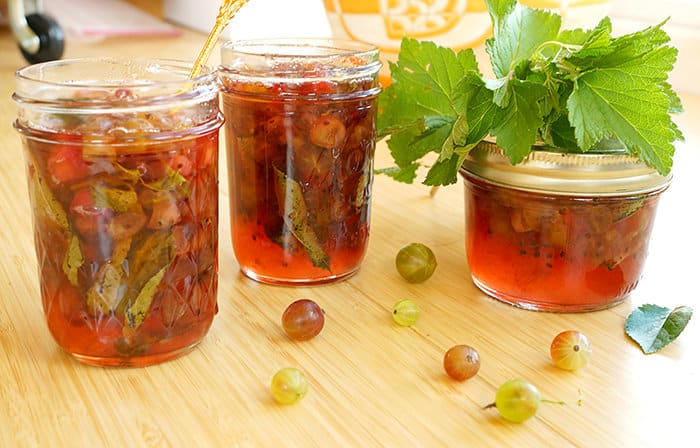
Harlequin gooseberries are grown from red varieties in the middle zone.. The height of the plant is up to 1.5 m, the leaves are large, matte, dark green. The berries are oval-round red. The taste is sour, refreshing and harmonious. The pulp is of medium density and is universal in use: suitable for processing, freezing, and preservation. Harlequin does not tolerate waterlogging and is demanding of sunlight. Productivity is from 3 to 5 kg of berries per season.
Pink, green and yellow
Pink variety Sirius mid-late ripening, frost-resistant, with immunity to powdery mildew. The bushes are tall, straight-growing, with a compact crown. The shoots are thick and straight, the leaves are matte, with slight pubescence. The berries are small, average weight - 2.7–3.5 g. The pulp is sweet and sour, tender, tasting score - about 4.4 points out of 10.
Universal purpose: fruits are eaten fresh, used for transportation and sale, making jam and compote. Thanks to the dense peel, the berries do not lose their taste and commercial quality for a long time.
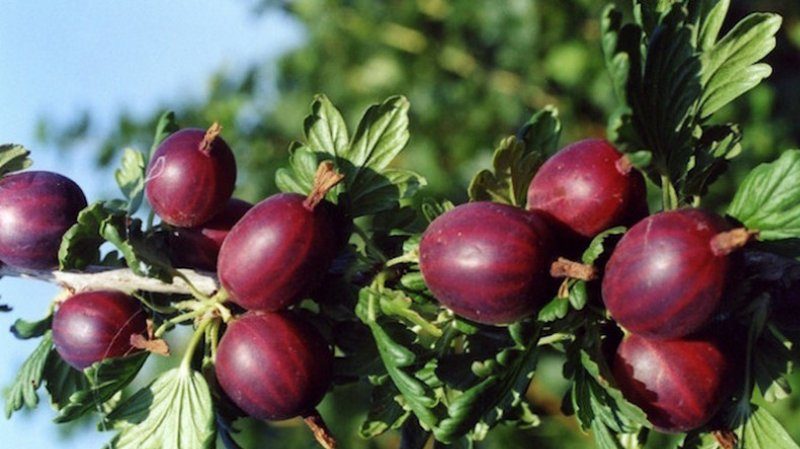
Among the yellow varieties for the middle zone, gooseberry Rodnik is distinguished. Early ripening dessert variety, resistant to septoria and anthracnose. The bushes are medium-sized, the crown is compact. The leaves are large, dark green in color with slight pubescence. The berries are oval-round, yellow in color, with a greenish tint. The skin is medium thick, the flesh is juicy and sweet. Fruit weight is about 5 g, yield is 3-4 kg per season.
Interesting! To get a rich harvest, gooseberries are planted next to red and black currants. Unfavorable neighbors are strawberries and raspberries.
Mid-season green gooseberry Malachite grown throughout the country.The ripening period is average, the shrub is unpretentious in care, moderately resistant to anthracnose, sawflies and moths, and is damaged by septoria. The bushes are tall, with a semi-spreading crown. The weight of the berry is from 4 to 7 g, the shape is round or pear-shaped, the color is light green, the peel is translucent. There is slight pubescence. The pulp is tender, the taste is pleasant, sweet, with sourness.
The purpose of Malachite is technical: jam, marmalade, confiture, marshmallows, and jams are prepared from the berries.

The sweetest
The taste of berries is one of the main criteria that gardeners pay attention to when choosing a variety. Sweet fruits are suitable for any type of processing and fresh consumption.
Black and red
Sweet black gooseberry Grushenka medium-sized, compact, suitable for growing in small garden plots. The leaves are dark green, with a smooth shiny surface. The berries are elongated pear-shaped, dark plum or black in color. The weight of the fruit is about 4 g, the peel is dense, so the crop is used for transportation over long distances. The taste is rich and sweet. The ripening period is average, the harvest is harvested at the end of June and until mid-July. The plant produces up to 6 kg of berries per season.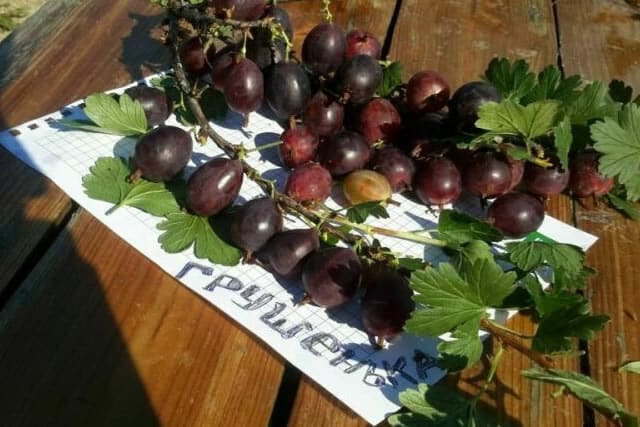
Red thornless gooseberry Vladil It is distinguished by tall bushes with long and thin shoots. The leaf blades are large, straight, dark green. The berries are red, round, average weight - 2.8 g. The taste is pleasant, tasting score - 4.2 points. Vladil is winter-hardy and not affected by powdery mildew. It bears fruit early, the first berries are harvested 3 years after landings. Productivity - up to 5 kg per plant.
Pink, green and yellow
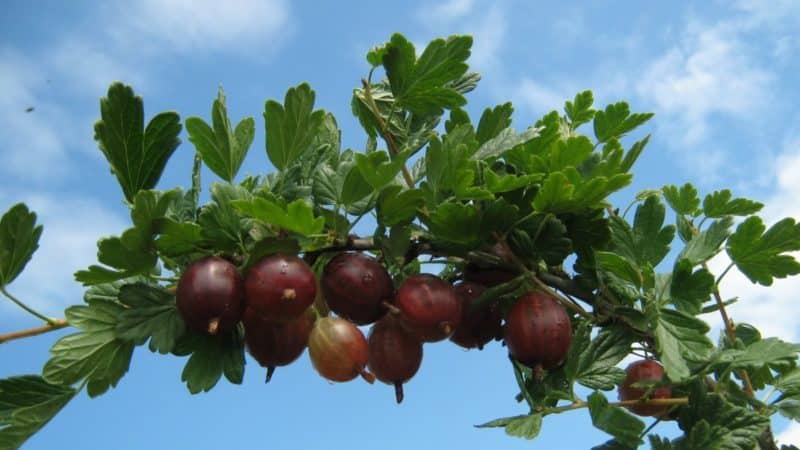
Pink gooseberry Kolobok recommended for cultivation in the central part of Russia, warm regions and Eastern Siberia.Ripens at the end of July, resistant to fungal diseases. The bushes are medium-sized, spreading and dense. The berries are round, the skin is dense. The color ranges from pink to purple, depending on how long the ripe fruit hangs on the branches. Berry weight is from 4 to 8 g, yield is up to 6 kg per plant. The purpose is universal. Tasting score: 4.5 points.
Green sweet and large gooseberry Grossular refers to mid-season. The height of the bush is up to 1 m, the leaves are medium sized, green. The shoots are straight, light brown in color. The weight of the berry is from 4 to 9 g, the shape is teardrop-round. The color is light green, the peel has a slight waxy coating, and is elastic. The pulp is tender and juicy, the taste is sweet. Grossular is used for homemade preparations and eaten fresh. The plant is rarely damaged by insects and does not require special agrotechnical rules for cultivation. Suitable for growing in the Urals and Siberia, it takes root without problems in the south and in Moscow region.
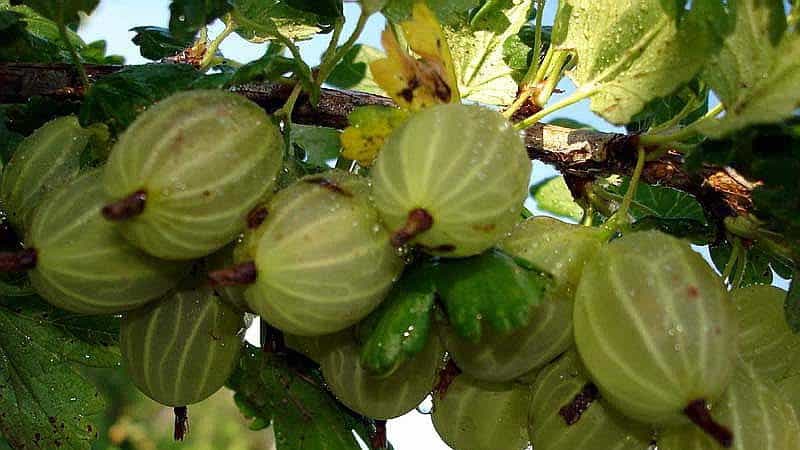
Interesting! There is an opinion that the more spines a gooseberry has, the sweeter and tastier the berries. This is not true - there is no connection between the thorniness and the taste of the berries.
Yellow sweet gooseberry Favorite They were named so due to their delicious fruits and ease of cultivation. The favorite is early ripening, the first harvest is harvested after June 25. The purpose is universal, there is immunity to insect pests and diseases. The bushes are medium tall, the leaves are medium light green. The fruits are round, yellow, with a greenish tint. The peel is thin, translucent. The taste is sweet, tasting score - 5 points. The favorite is frost-resistant, the yield is from 3 to 6 kg per summer.
Large-fruited
Large berries are used for canning, frost, processing.Such varieties require special care: they are tied to a support so that the branches do not break under the weight of heavy fruits.
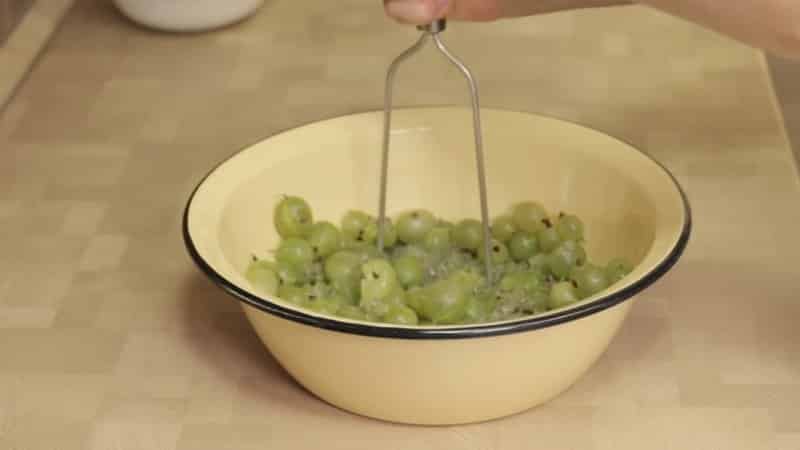
Red and black
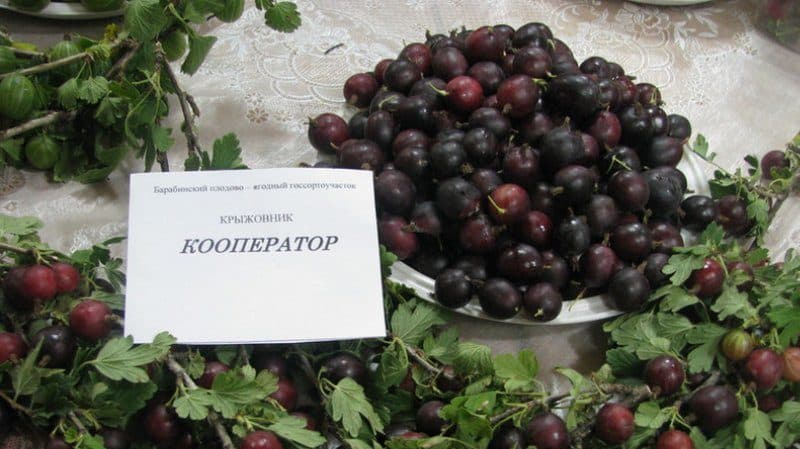
Black gooseberry without thorns Cooperator ripens in late July or early August. Fruiting lasts 2-3 weeks, the berries do not fall off or crack. The cooperator is heat-resistant and frost-resistant, weakly affected by powdery mildew and septoria. The bushes are slightly spreading, medium-sized, shoots with slight pubescence. The berries are pear-shaped, weigh up to 7.5 g. The color is from dark red to black, the peel is thin, with a thick waxy coating. The taste is sweet and delicate, tasting score - 4.8 points. Cooperator is grown in the Ural and West Siberian regions. The average yield is 5 kg per plant.
Interesting! Homemade gooseberry wine resembles white grape wine in taste and aroma. For cooking, it is recommended to use yellow or red large gooseberries.
Variety Prune They are valued not only for the absence of thorns, but also for their attractive commercial qualities. The weight of the berry is from 4 to 8 g, the shape is oval, the color is rich red. The variety is winter-hardy, the ripening period is medium. The bushes are medium-sized, with straight and thick shoots. The berries are without pubescence, with a thick waxy coating. The taste is specific, sweet and sour, with a pleasant aroma. Wines and compotes are prepared from Prunes.
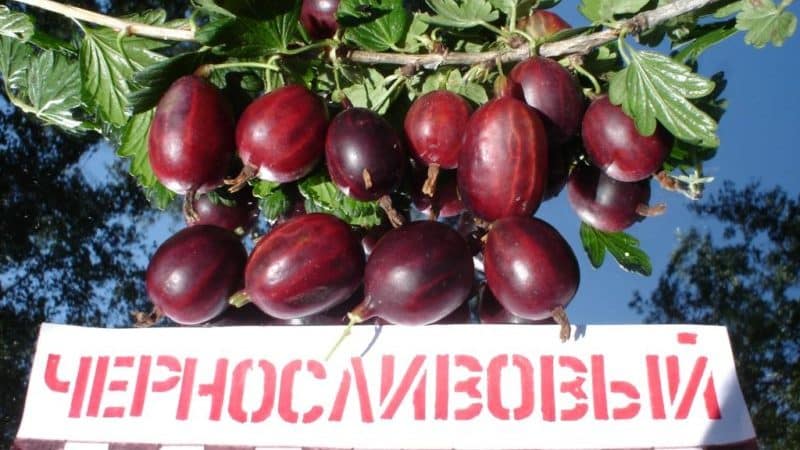
Pink, green and yellow
- Gooseberry Pink 2 mid-early and winter-hardy, almost not affected by powdery mildew. The bush is medium-sized, with thick shoots. Suitable for cultivation in the Central and East Siberian regions. Productivity - 3-4 kg of berries per bush. The round fruits weigh up to 10 g each, the color changes from pink to dark red as the berries ripen.The skin is dense, so the crop is suitable for transportation. The taste is excellent, the score is 4.9-5 points, the purpose of gooseberries is universal.
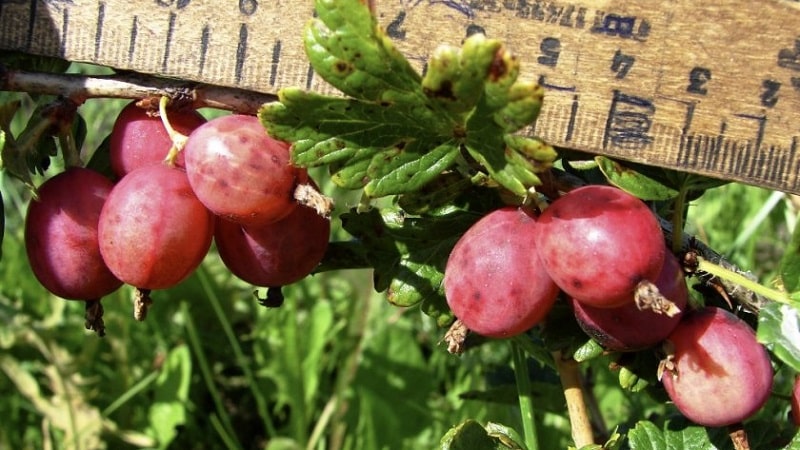 Gooseberry Pink 2
Gooseberry Pink 2 - Green gooseberry Naughty medium height The leaves are small, smooth, rich green. The berries are round, the average weight is 5 g, some specimens reach 10 g. The skin is thin and transparent, so the fruits are not used for long-term storage. The taste is original: sweet, with a pleasant sourness. The ripening period is average, the harvest is harvested by the middle or end of July. One plant produces up to 7 kg of berries per season. Shalun is unpretentious in cultivation, but to obtain a rich harvest it is recommended to plant it on light and nutritious soils.
- Yellow variety Altai resistant to powdery mildew, bears fruit consistently for 3 years after planting. The plant is medium-sized, the shoots are straight, thin, the leaves are light green. The weight of the berry is up to 8 g, the taste is sweet and dessert. The ripening period is mid-early, the flowers are frost-resistant. The fruiting period is extended: the harvest is harvested over 2-3 weeks. The use of berries is universal.
Features of planting and caring for gooseberries without thorns
The yield of gooseberries depends on whether the planting rules and care recommendations are followed. Growing a thornless shrub is not much different from cultivating a plant with thorns.
Landing rules
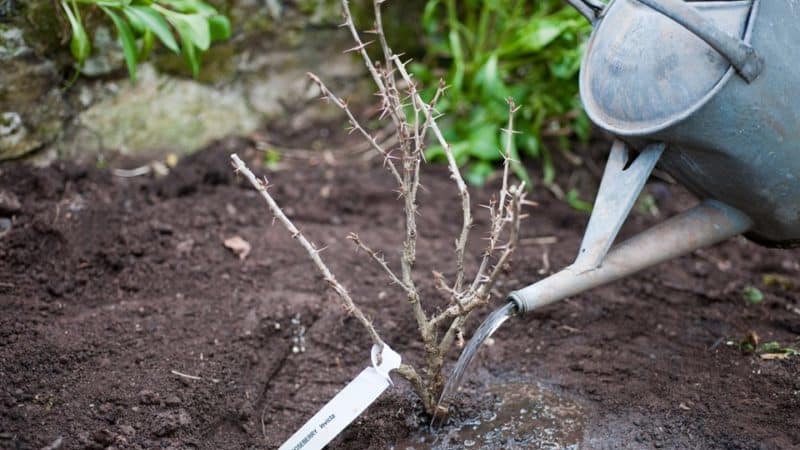
In the shade, gooseberries develop poorly: the shoots will be weakened, the berries will be small, and the taste will be bland. Therefore, the plant is planted in well-lit areas. The soil should be light and nutritious, with neutral acidity. Sandy loam soil is ideal, but clayey areas are best avoided.4 weeks before planting, dig holes and fertilize them with a mixture of rotted manure and double superphosphate.
Attention! The seedlings are pre-soaked in a growth stimulator, after which all dried shoots and damaged roots are removed. The bush is placed in the hole slightly at an angle, the roots are sprinkled with soil and compacted with hands, then watered with warm water.
Thornless gooseberry planted in autumn, not spring. This is done 5 weeks before frost, so that before the onset of cold weather the young plant has roots and has time to take root in its new location. The distance between the bushes should be 1.5–2 m, otherwise they will interfere with each other. Compact plants are planted along the fence or made into a hedge.
Growing and care
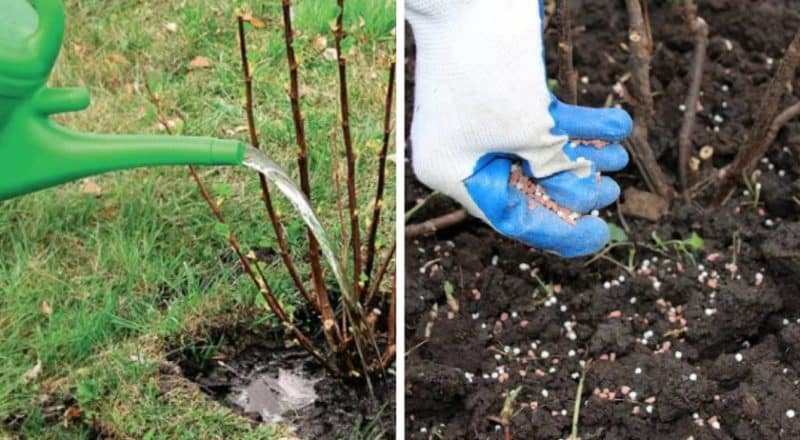
Throughout the life of the shrub, weeds are regularly removed and the beds are loosened - this guarantees the flow of oxygen to the roots, stimulates photosynthesis and fruit development. Fertilize gooseberries every 3-4 weeks fertilizing based on ammonium nitrate, superphosphate, urea, potassium chloride. Before fertilizing, the plant is watered in dug grooves or trenches.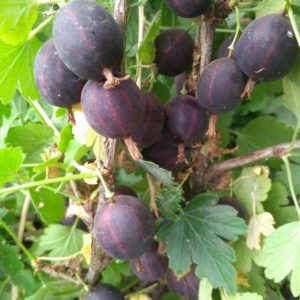
An important stage in care is the formation of bushes and pruning of excess shoots. In the first 2-3 years, the skeletal branches are shortened and all root shoots are removed. In the 4th year, all diseased and dry shoots, as well as branches growing in a chaotic direction, are pruned. Form and trim gooseberries at the end of October or March.
The crop is treated against diseases and insect pests. If prevention is not carried out, the plant is attacked by sawflies, mole crickets, aphids, and spider mites. Once a month, the plant is sprayed with soap or tobacco solution.If there are already signs of infection, use a solution of copper sulfate or Bordeaux mixture.
Conclusion
Thornless gooseberries are grown in Moscow and the Leningrad region, in the Urals and Siberia, southern regions. Before planting, study the descriptions of varieties and reviews from experienced gardeners. For example, from the sweet varieties there are non-thorny gooseberries Grushenka, Lyubimets, Vladil, from large-fruited ones - Kooperator and Shalun.
Sunny and hilly areas are allocated for cultivation. Care consists of watering, fertilizing, shaping and pruning. Most varieties are universal in use and are useful for preparing delicious and healthy desserts.